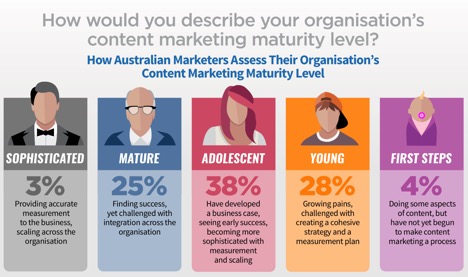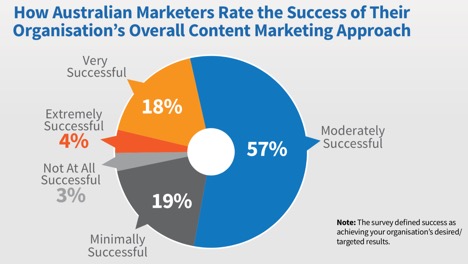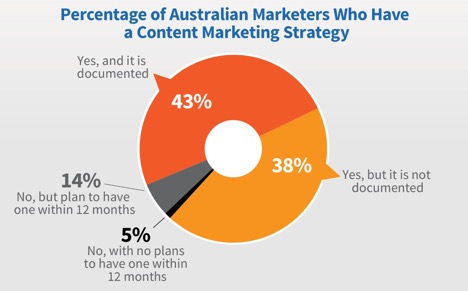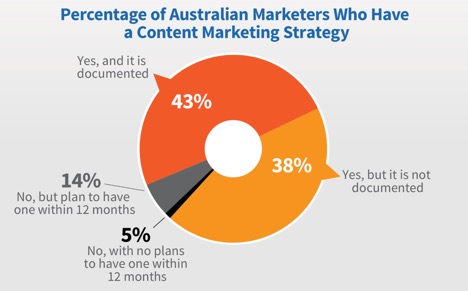When I first started speaking about content marketing back in 2009, no one knew what I was talking about. It wasn’t that long ago I was being asked to speak and present to audiences for whom content marketing was a new concept.
We’ve seen a massive shift in attitudes in Australia over the past few years, and content marketing is finally getting the attention it deserves as a plausible strategy for business. While this is extremely encouraging, we still have a long way to go before business starts to see the benefits associated with a content marketing initiative.
So, what’s holding us back?
Sidebar: What is content marketing?
According to the Content Marketing Institute, content marketing is “a strategic marketing approach focused on creating and distributing valuable, relevant, and consistent content to attract and retain a clearly defined audience—and, ultimately, to drive profitable customer action.”
Australia hooked on content marketing
According to the 2018 Content Marketing in Australia: Benchmarks, Budgets, and Trends report from the Content Marketing Institute, 85 per cent of Australian marketers use content marketing.
Not only are Australian marketers using content, 66 per cent are reaching maturity levels only seen through consistent planning and activity. So that means content is enjoying widespread acceptance in marketing circles.

While that’s great news, the same research shows only 22 per cent consider themselves very successful or extremely successful at achieving their organisation’s desired results. That leaves many marketers struggling with the effectiveness of their content marketing efforts.

Identifying a big weakness in content marketing
So, what can be done to improve effectiveness? I believe the answer lies in another interesting statistic in the report. Only 43 per cent of Australian marketers have a documented content marketing strategy.

A total of 38 per cent of Australian marketers claim to have a strategy althoughthey say it’s not documented. Unless you’re the sole proprietor of your business, or you employ mind readers in your marketing team, having an undocumented content marketing strategy is surely the same as admitting you don’t have a strategy at all.
[tweet] Unless you’re the sole proprietor of your business or you employ mind readers in your marketing team, having an undocumented #contentmarketing strategy is the same as no strategy at all, says @SarahMitchellOz. [/tweet]
Three questions immediately come to mind for companies working without a documented strategy:
- How do you determine budget? Without a clear plan on the audience you want to reach, along with their habits and preferences for content consumption, it’s impossible to develop a budget that takes into account production, distribution, and amplification costs. Depending on the size of your team, and the amount of activity needed to meet your business goals, you may also need to hire staff. None of this is possible without a documented strategy, especially if you have to make a business case for budget. (And who doesn’t have to do that?)
- What guides your production efforts? It’s easy enough to pick two or three types of content and get busy with production. (Social media, pre-produced video and illustration/videos top the list for most common types of content.) But, without a strategy, how do you know what’s going to resonate with your audience? Producing content can be expensive, but it will never convert to a business asset if you’re off the mark on your messaging or out of sync with the very people you’re trying to reach.
- How can you measure effectiveness? Marketers say they’re spending, on average, 23 per cent of their marketing budget on content. That’s a big chunk to dedicate to a discipline, warranting regular reporting against performance. But here’s the thing; if you don’t measure, you can’t report. If you can’t report, it’s hard to get additional budget whether your efforts are working or not. Alarmingly, only 41 per cent of marketers surveyed said they measure the return on their content marketing initiative, so it’s easy to see a vicious cycle brewing before content marketing can be embedded in an organisation.
What worries me is that many companies without a documented strategy soon conclude content marketing doesn’t work – or that it doesn’t work for them.
[tweet] Many companies without a documented strategy soon conclude that #contentmarketing doesn’t work – or doesn’t work for them – which just isn’t true. [/tweet]
Another concern is that many of the ‘strategies’ I’ve seen aren’t really strategies but more like a collection of unrelated tactics. It’s not unusual to discover a company with a content strategy that doesn’t address distribution or amplification. (Don’t get me started on why I think a social media strategy or an SEO strategy are not strategies at all – I’ll leave that for another post.)
What this means for business
Before you head down the content marketing path, I urge you to invest time and budget into developing a documented strategy for your business. Not only will it provide a valuable roadmap for your content marketing, it will also give you the ability to measure effectiveness. I’m a firm believer that high-quality, original content is a long-term business asset – but only if it supports your objectives and goals.
And here’s one last thing to think about – 88 per cent of Australian marketers plan to retain the same or increase their content marketing spending in the next year. That’s even more reason to get a documented strategy in place.

Find all the insights from the 2018 Content Marketing in Australia: Benchmarks, Budgets, and Trends report.
If you’d like to know more about the value of a content marketing strategy, do get in touch.
Graphs courtesy of the Content Marketing Institute.
